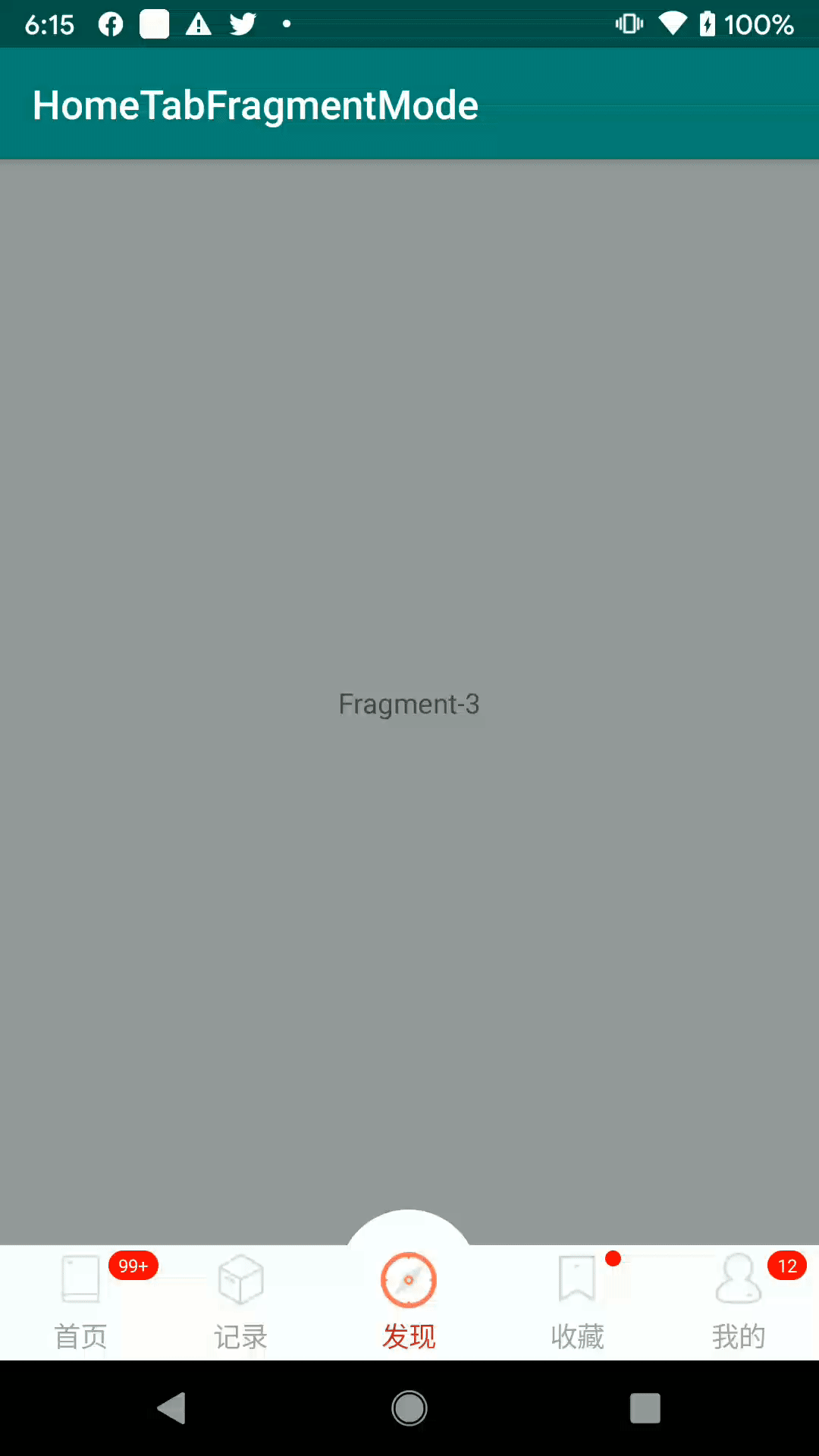利用HomeTabModeHelper2分鐘快速搭建Tab+Fragment主頁框架
前言
在如今各種App模式如出一轍、各個程式設計師們卻各式各樣花式實現效果的環境下,每接手一個專案,就能看到專案程式碼又不一樣,分分鐘想統一。同時為了加速後續新應用的開發,封裝搭建了這麼一個初步的簡易框架,實現兩分鐘快速無腦構建首頁。
話不多說,先看實現的效果:

簡介
實現功能:
- tab+fragment模式首頁搭建
- 支援ViewPager
- 支援小紅點展示(可選是否展示數量)
- 支援突出展示某一個tab
- 動態隱藏tab
使用
匯入庫
implementation 'com.moore.lib:homeTabModeHelper:1.0.0'
若沒有新增jcenter()倉庫地址記得新增~
設定tab
我們使用.json檔案進行設定,然後該檔案存放於assets中。設定參考如下:
{
"textColorNormal": "#A4A3A3",
"textColorSelected": "#C02221",
"textSizeNormal": 14,
"textSizeSelected": 14,
"backgroundColor": "#e9e9e9",
"isNameResId": false,
"isTitleVisible": true,
"tabs": [
{
"tabName": "首頁",
"tabTag": "key_index_fragment",
"iconNormal": "main_home_tab_index_normal",
"iconSelected": "main_home_tab_index_selected"
},
{
"tabName": "發現",
"tabTag": "key_discover_fragment",
"iconNormal": "main_home_tab_discovery_normal",
"iconSelected": "main_home_tab_discovery_selected",
"isOverSide": true,
"itemBg": "home_tab_center_bg"
},
{
"tabName": "我的",
"tabTag": "key_user_fragment",
"iconNormal": "main_home_tab_mine_normal",
"iconSelected": "main_home_tab_mine_selected"
}
]
}
這裡解釋一下各個設定的作用:
首先是tab文字描述的2個屬性,2種狀態textColorNormal,textColorSelected,textSizeNormal,textSizeSelected,這幾個屬性作用於tab標題的文字顏色和大小。
isNameResId:表示標題是否為string中資源id,為false的時候直接取設定的tabName,否則獲取對應id的資原始檔。預設為true
isTitleVisible:標題是否可見。預設為true
tabs:tab列表
每一個tab的設定中:
tabName:tab標題,若使用string.xml設定,則為string對應的id
tabTag:重要,用於區分每個tab對應的Fragment的tag,不能重複
iconNormal,iconSelected:兩種狀態對應的圖示,請放在drawable而不是mipmap中
可選項:
isOverSide:Boolean型,如果需要凸出展示,可設定該屬性,樣式參考上面效果圖
itemBg:設定凸起展示後,可設定背景,一般是個半圓、原型背景之類的
首頁使用
在主頁對應的xml檔案中,只要簡單的進行如下使用就可以了:
關鍵引數設定:
container_id:指定Fragment展示的佈局id
config_file_name:assets中組態檔名稱,全名
viewPager_id:和container_id二選一,設定這個的話則為ViewPager可滑動模式,對應的id關聯的是ViewPager佈局
<androidx.constraintlayout.widget.ConstraintLayout xmlns:android="http://schemas.android.com/apk/res/android"
xmlns:app="http://schemas.android.com/apk/res-auto"
xmlns:tools="http://schemas.android.com/tools"
android:layout_width="match_parent"
android:layout_height="match_parent"
android:background="#999999">
<FrameLayout
android:id="@+id/main_content_layout"
android:layout_width="match_parent"
android:layout_height="0dp"
app:layout_constraintBottom_toTopOf="@id/main_tab_layout"
app:layout_constraintTop_toTopOf="parent"
app:layout_constraintVertical_weight="1" />
<com.moore.bottomtab.HomeBottomTabLayout
android:id="@+id/main_tab_layout"
android:layout_width="match_parent"
android:layout_height="58dp"
android:background="#ffffff"
app:config_file_name="tab.json"
app:container_id="@id/main_content_layout"
app:layout_constraintBottom_toBottomOf="parent"
app:layout_constraintTop_toBottomOf="@id/main_content_layout" />
</androidx.constraintlayout.widget.ConstraintLayout>
主頁程式碼
class MainActivity : AppCompatActivity(), HomeBottomTabLayout.HomeBottomTabLayoutCallback {
//每個tab對應的tag,和json組態檔中保持一致
val TAG_INDEX = "key_index_fragment"
val TAG_NAME = "key_name_fragment"
val TAG_DISCOVERY = "key_discover_fragment"
val TAG_COLLECT = "key_collect_fragment"
val TAG_USER = "key_user_fragment"
override fun onCreate(savedInstanceState: Bundle?) {
super.onCreate(savedInstanceState)
setContentView(R.layout.activity_main)
//設定回撥
main_tab_layout.setHomeBottomTabLayoutCallback(this)
//初始化,引數為預設展示第幾個tab
main_tab_layout.initFirstTab(2)
//如果需要展示未讀訊息,通過該方法展示
main_tab_layout.setUnreadTip(TAG_USER, "12")
main_tab_layout.setUnreadTip(TAG_INDEX, "99+")
main_tab_layout.setUnreadTip(TAG_COLLECT, null, false)
}
override fun getFragmentByTag(tabTag: String): Fragment? {
//根據對應Tag名稱,返回具體的Fragment物件
when (tabTag) {
TAG_INDEX -> return Fragment1()
TAG_NAME -> return Fragment2()
TAG_DISCOVERY -> return Fragment3()
TAG_COLLECT -> return Fragment4()
TAG_USER -> return Fragment5()
}
return null
}
override fun onClickChangeTab(selectedIndex: Int, selectedTag: String?) {
//點選tab回撥,可在此進行統計事件、隱藏訊息提示等操作
}
}
至此,您可以執行您的app試一下,可以看到一個Tab+Fragment的結構已經出來了,非常簡單方便,再也不需要各種xml排版、程式碼中點選回撥、Fragment切換等等複雜操作,程式碼也很清晰明瞭。
更多方法
setUnreadTip("tagName","unReadCount",isShowCount):設定未讀訊息提示,根據tag設定對應的tab,第二個引數為提示數值,第三個為是否顯示具體數量還是隻展示小紅點。
hideUnReadTip(tag: String):隱藏未讀訊息提示
getFragmentList(): List<Fragment?>?:獲取新增的Fragment列表
getFragmentByTag(tabTag: String): Fragment?:根據Tag獲取Fragment
getCurrentSelectedFragment(): Fragment?:獲取當前選中Fragment
getCurrentSelectedIndex(): Int:獲取當前選中Fragment的下標
getCurrentSelectedTag(): String:獲取當前選中Fragment的Tag
selectByTag(tabTag: String):根據tag選中該tab
hideTab(index: Int):隱藏某個tab
結語
該框架主要還是針對日常開發中經常遇到的一些功能的封裝,不涉及太多複雜的邏輯和處理,旨在幫助提升我們的開發效率,如有用到覺得還不錯的小夥伴,也請點個贊哦~